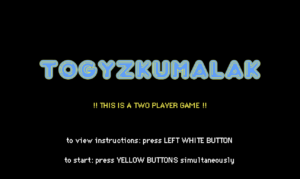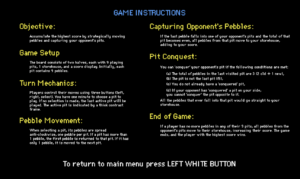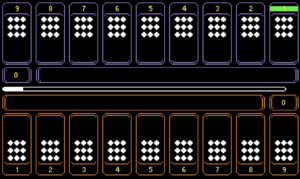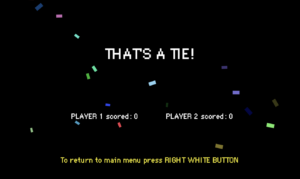TO VIEW THE P5 CANVAS FULLSCREEN CLICK HERE.
To view the code click here.
CONCEPT
For my final project, I created a version of the Kazakh traditional two-player board game, Togyzkumalak (transl. “nine pebbles”). The game board is visualized on a p5 window, which is displayed to players through a laptop screen. The board consists of two halves, each half features 9 playing pits, 1 storehouse, and a score display.
At the beginning of the game, each pit contains 9 pebbles. Players control their moves by using a set of three buttons (left, right, enter), featured on the arcade cabinet. Each player is given a minute to choose a pit to play. If the “select” button is not pressed by the end of the timer, the last active pit will be played. The active pit is indicated by a thick contrast frame around the pit. The pebbles from the chosen pit are spread in an anti-clockwise direction, one pebble per pit. If there is more than 1 pebble in the pit, the first pebble is put back into the pit it was taken from. If there is only 1 pebble in the pit, the first pebble is moved to the next pit. If the last pebble to be moved is put into one of the opponent’s pits and the total of the pebbles in that pit is an even number, all of the pebbles from that pit get moved to the player’s storehouse and add to their total score.
The opponent’s pit can be “conquered”, meaning that all the pebbles that ever fall on that pit will move to the player’s storehouse. However, there are some more conditions that need to be followed to do that (checked by p5 automatically):
-
-
-
- the total of the pebbles in the last pit you’ve visited must be 3 (2 old +1 new);
- the pit shouldn’t be the last pit of the player (pit #9);
- you must not already have a “conquered” pit;
- if your opponent already has “conquered” a pit on your side, you can’t “conquer” a pit that is opposite to it;
-
-
If one of the players doesn’t have any more pebbles in any of their 9 pits, the opponent’s pits are emptied into their storehouse, incrementing their score. The game ends and the player with the highest score wins.
IMPLEMENTATION
INTERACTION DESIGN
The game is hosted on a 30*40 acrylic arcade cabinet, which features two sets of game control buttons, a menu button, and an instructions button. For the screen, I am using a 13-inch laptop, the keyboard part of which is hidden in the cabinet, so that only the screen can be seen and accessed by the players. Along with the lower part of the laptop, the Arduino setup is also neatly organized inside the cabinet. To fit both without the size of the cabinet, I have put a small box inside the cabinet. The box plays two roles, it is both a home for the Arduino kit and a pedestal for the laptop. I have used a laser cutter, duct tape, bolts, and acrylic glue to assemble the cabinet. Below the cabinet, there is a box the pure function of which is to lift up the cabinet and make the whole setup look less disproportionate.
The biggest challenge at this stage was cutting the elements individually. The laser cutting machine died in the process multiple times, which made the process very time-consuming.
ARDUINO CODE
Setting up the Arduino code was pretty intuitive. It is fully based on the example provided by the professor in class. The code consists of the declaration of 8 buttons and their states. The state of each button is read and sent to p5. An empty line is sent from p5.js to Arduino.
To view the code scroll to the end of the sketch.js file in p5. Click here to view the p5 code.
P5.JS CODE
Most time was spent on setting up p5 canvas. There are four game states (start, playing, end, and instructions) that constitute the window displayed. The title page features a blinking text to serve as a sort of warning that the game requires two players. I found it necessary to add this warning and make it visible because my midterm project was also a two-player game and despite stating in class that it is multiplayer, my fellow classmates would still attempt to play it individually, which really breaks the experience. I decided to feature instructions on a separate page because (a) I didn’t find a way to make them concise enough to feature on the title page, and (b) I believe that there will be some people who know the instructions of the game. For the end screen, I have adopted the confetti display to make it feel less empty and more festive.
The arcade style of the game was dictated by the arcade cabinet and my general liking of this style. I find the arcade art style to be fitting for whatever game idea. It is easy to implement, not too difficult to modify if needed, and makes the game look more put together.
To explain the code in a more organized way, I will be focusing on each of the major functions of the game.
Turn mechanics
The turn mechanics in the game involve managing the timer, checking if a selected pit is empty, and handling situations where a selection is not made within the allotted time.
The game utilizes the frameCount variable to keep track of the elapsed time. The timeStart variable is set to the current frameCount value at the start of a player’s turn. The timer bar is displayed, indicating the remaining time for the player’s turn. If the timer reaches the time set for a turn, the turn is automatically ended.
If the player does not make a selection within the allowed time (e.g., before the timer reaches the threshold), the turn is automatically ended and whatever pit their selection window was on, would be played. If the last selected pit is empty, pit index + 1 would be played. This is achieved by comparing the current frameCount value with the timeStart value and determining if the time limit has been exceeded. When the turn times out, the game proceeds to the next player’s turn.
Pebble movement
When there are multiple pebbles in a pit, the game determines the number of pebbles to be moved. If the pit has more than one pebble, the ballCount variable is set to the number of pebbles in the pit minus one. The pebbles are then moved one by one to the subsequent pits in an anti-clockwise direction. If there is only one pebble in the pit, a specific rule is applied. The ballCount variable is set to 1. If a player selects an empty pit, no pebbles are moved, and the player is forced to choose a pit that has pebbles in it.
Capturing opponent’s pebbles
After moving the pebbles to their respective pits, the game checks whether the total number of pebbles in the last pit visited on the opponent’s side is even. This is done by checking the index of the pit using modulo division (%), which checks if the remainder of the division by 2 is 0, indicating that the pit is even. If the final pit has an even amount of pebbles, the player’s score is incremented by the number of pebbles in the opponent’s pit. The player’s storehouse and the opponent’s pit are updated to reflect new values.
End of game
After each move, the game checks if the current player has any remaining pebbles in their pits. This is done by iterating through all nine pits of the current player and summing up the number of pebbles in each pit. If the total count of pebbles in the player’s pits is zero, it indicates that the player has no more pebbles to play with. The game state changes to “end” and the end window is displayed. The scores are compared to choose which ending message to display. An alternative way of finishing the game is by pressing the right white button.
FUTURE IMPROVEMENTS
There are a few. For a better experience of the game, it would be nice to have sound effects, music, and animations. I am an advocate for adding sound to whatever experience that doesn’t require a complete lack of sound. Especially if it’s a game. However, this time I really didn’t have the time to add by the project submission deadline. I may add it by the time of the showcase if I have some free time. As for animations, I just couldn’t figure it out. Perhaps if the distribution of the pebbles was slower and more emphasized, it would be easier to figure out the game flow for those, who didn’t understand it from instructions.
In the original game, there is also a different kind of pebble, but I don’t remember what rule is associated with it and surprisingly can’t find anything online. I do believe that it added more complexity to the game, however, it is currently difficult to explain instructions in simpler terms as it is. So for the starters, I wanted to focus on making the game’s logic and objective as understandable as possible without taking away from the strategic aspect of it.
Coming back to the display of the instructions, I feel like right now it is the biggest challenge of the game. While after user testing I was planning to have some visuals to accompany the rules, I realized that it would be more effective to explain the game in as many details as required to make the game make sense. In case players at any point want to clarify something about the rules, they can always press the button allocated specifically for this purpose. The game timer pauses for the duration of the instructions display so that players wouldn’t feel in a hurry and could actually focus on understanding the game.
One other thing is that even though it is written that to start the game players must press the yellow buttons simultaneously, most lack the group coordination to do so. I implemented this rule as one way of ensuring that there are two players at the start of the game. Maybe there is some condition I could add to make it so that as long as the other player presses within some brief time window from the first player to press the yellow button on the title screen, the game could be started.




